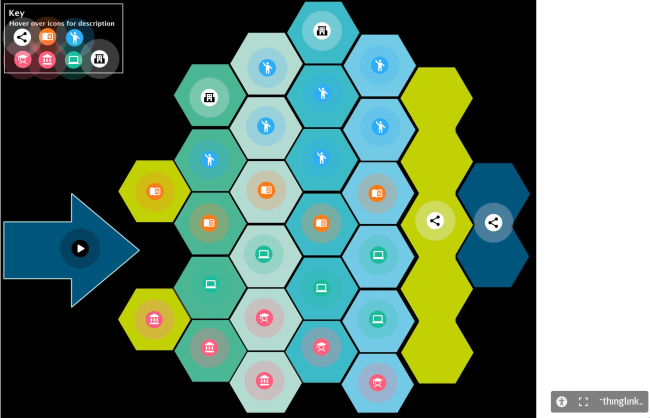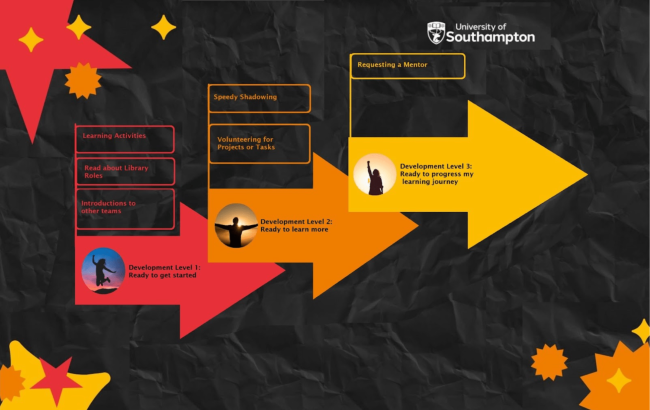There was a time when careers followed linier pathways and people picked on a career and stuck with it for life. That hasn’t been the case for a long time, but have we updated our career development support to match this more flexible world? Back in 2023, Ian Whiting shared this the analogy proffered by Paul Stevens “There is no such thing as a career path anymore – it is crazy paving and you have to lay it yourself !”
Instead, we’ve evolved our language to talk about ‘career journeys’. A journey is something where you plan your own destination, you plan your route, you own every decision at each junction. However, without signposts, a journey can seem daunting. The solution is a career map: a set of support and guidance to help signpost people find their own route.
For some, this might mean staying in their current role and developing to be their best self. For others, they may be looking for a more traditional progression. And for others, sideways and diagonal moves, or career pauses to do other things in life, provide more flexibility. I’ve used Ian Whiting’s suggested hexagon approach to help illustrate how our staff can hopscotch to different roles in our Library service. (see attached image or view at https://www.thinglink.com/card/1732810081218593445).

Essential to setting people up for success with career journey planning, is providing development and support. To help staff take the steps they want, I’ve signposted the learning options and help them see what is best in their particular situation. (see attached image or view at https://www.thinglink.com/card/1732810081218593445). This has been about collating existing learning support from our organisation and making sure we fill in any gaps. There are three ways which people can pick the right development for them.

- Signposting By Career planning development level.
Using Blanchard’s SLII Development levels, I’ve helped signpost the right types of development depending on how far along someone is with their career planning.
For those who are ready to get started, but not sure what they want to do, I’ve classed that as Development Level 1 for career planning. At this stage I’ve provided reading about every role, courses and online learning and short introductions to find out what other teams do.
For those who are ready to learn more about a specific role, I’ve classed as Development Level 2. We’ve introduced speedy shadowing, up to 2 hours with a specific learning aim. I also recommend ways to gain experience through taking on different tasks or project work.
For those who are ready to progress and know what they want, or perhaps have recently changed role, that’s Development Level 3. To build their confidence I’ve recommended mentoring, which fits with their more focussed learning aims at this stage. - Signposting By Role
Using the hexagons diagram, or from a list of all roles, Library staff are able to see information about every job role. Staff had fed back that our official job descriptions were too complex and the language was difficult to understand. So we summarised 3-4 bullet points for each role of:
1. The key skills you need to have BEFORE you apply and, essentially
2. The ways you can develop those skills before you are in post.
This helps break the vicious cycle of not being able to get a role without experience, and not being able to get experience before you are in the role. Instead, we signpost exactly which courses will help, what to read and how to gain experience of the transferrable skills which will be sought at interview.
- Signposting by Unique You
The process of developing at work and applying for roles is designed to be fair and equal – everyone has the same opportunities and follows the same processes. However, equal isn’t the same as equitable, so we recognise the need for extra support to help level the playing field. We are transparent about our organisational pay gaps nationally. We signpost specific support networks for different protected characteristics, share inspiring case studies from within our organisation and recommend courses and online resources.
Whilst this continues to be a work in progress, we’ve seen early indications that we are getting more internal applicants for vacancies in our Library service, and more of those applicants are reaching the interview stage. Much of what we’ve done requires no budget and no additional resources, but as learning professionals we can think about how we signpost what is relevant to a person in very different ways, without prescribing the pathway they need to take.
About the author: Lucy Marr is Learning & Development Lead for the University of Southampton Library. She is a CIPD qualified learning and development professional, with extensive experience of how learning links to career progression in different occupations across the public and HE sectors.
